How AT&T Sped up its 5G, Fiber Broadband Rollout and Services with Open, Disaggregated Platforms
2022 was pivotal for 5G rollouts and Fiber broadband expansion. And it stems from a vision and a plan to transform the network we began executing almost a decade ago to support our customers’ surging demand for connectivity.
5G – Three years after we launched 5G, it has become the fastest growing cellular generation. To put into perspective, it took 5G only 7 quarters to reach 250 million connections while 4G took 19 quarters to do the same.1 AT&T 5G now covers more than 288 million people, and our mid-band 5G+ is covering 150 million people. AT&T 5G+ over mmWave is available in parts of more than 50 cities and nearly 70 venues.
Fiber – As of Q4 2022, AT&T Fiber has the ability to serve more than 19 million consumer locations and more than 3 million business customer locations in more than 100 U.S. metro areas, and we are on track to pass 30 million-plus consumer and business locations by the end of 2025. Early in 2022, we launched and expanded our multi-gig services to offer up to 5 Gbps symmetric speeds to consumers and businesses.
This rapid deployment is not an accident. It is all done by design.
In 2013, we published our first blueprint for the network of the future. While the smartphone revolution was still in its early stages, our engineers and developers could see that the world was about to change. Data demands would increase faster than the network could grow if we stuck with the traditional, hardware-centric approach. As 4G took off and fiber and 5G were next up, our vision was of a software-centric model that put customers first. From large enterprises to the individual consumer, they need to be confident in the network they were riding on as those connections became increasingly central to every aspect of their lives and businesses.
AT&T Labs has been central in making that vision a reality. Just like your calculator, camera and other gadgets became apps on your phone, and light bulbs, thermostats, and other devices around your house became controllable over your home network, we’re turning network hardware into software and making it accessible remotely so we can upgrade and reconfigure it securely at internet speed.
But moving control of the network from hardware to software also meant we needed to look beyond the conventional way of using proprietary, “locked” equipment from a single vendor, to instead using decoupled, “open” components that can be stacked into one switching and routing platform. We call these open platforms “white box” systems.
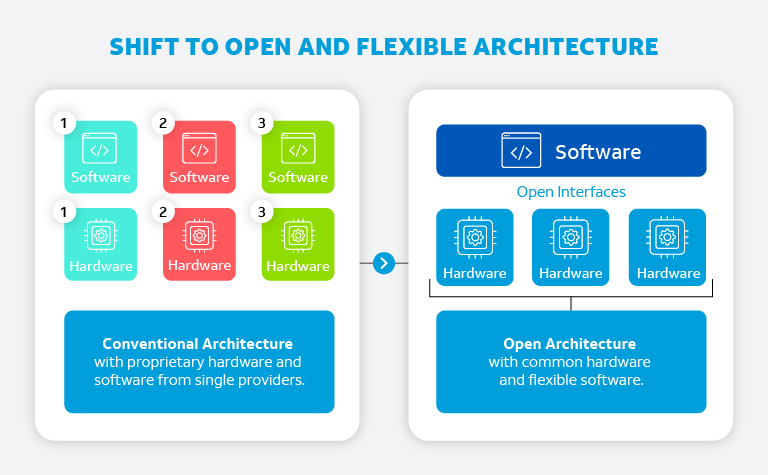
We unveiled our plan to develop an open white box system in 2019 that would enable us to run 10 times as much traffic.
What was vision then is here now, and we are starting to see its benefits. We announced the next-gen open disaggregated core routing and the next-gen open disaggregated IP edge routing platforms in 2020. And in 2022, our open, disaggregated program took a significant leap forward! In fact, it is meeting and, in many cases, exceeding our expectations. It has enabled us to be more efficient with our 5G and Fiber rollouts and launch high-speed broadband and 5G services to new markets much faster, as well as offer more advanced services in existing markets. Furthermore, it has minimized cost even as we manage more network traffic loads than ever before – more than 594 petabytes of global data traffic per day!
As of today, we’ve migrated more than 52% of all our production traffic to our Next-Gen Core routers, which are based on the Broadcom Jericho2, Ramon chips and uses the Distributed Dis-Aggregated Chassis (DDC) design powered by DriveNets Network Cloud DNOS software. We are now exploring a path to scale the system to 500Tb/s and then to 900Tb/s using next-gen chipset.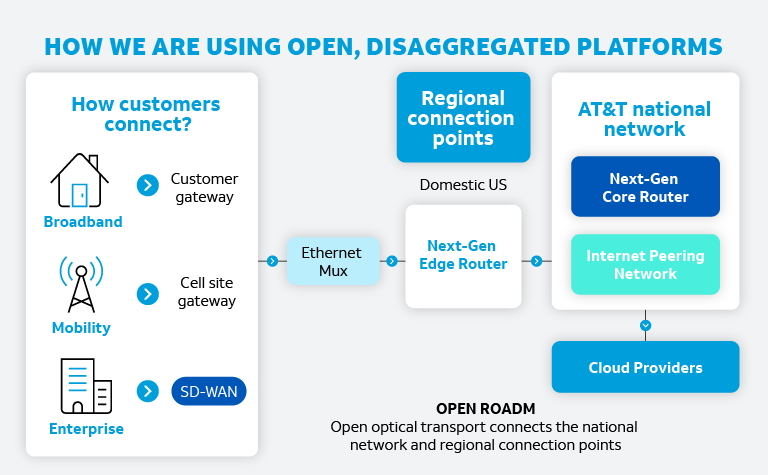
Here’s a progress update on our other open, disaggregated platforms:
Next-Gen Edge Router – This platform provides our enterprise services, Ethernet, Broadband, Mobility, and Internet Gateway using Broadcom, Cisco, and UfiSpace hardware. We’ve now deployed it in AT&T production Internet peering network.
Cell Site Gateway Router – This supports up to 100Gbps Mobility transport to provide the bandwidth demands that come with 5G services. This solution uses hardware from UfiSpace, Broadcom Qumran-AX chips, coupled with the Vyatta NOS software from Ciena. This has been deployed in AT&T’s mobility network.
Ethernet Mux – This enables aggregation of 1 and 10 Gig access ports to 100 Gig transport. This platform is based on Broadcom’s Qumran-MX chips and uses EdgeCore hardware with Ciena’s SAOS Network Operating System software. This is now live on our Metro Ethernet and fiber footprint.
Universal CPE – This broadband customer premise equipment today now provides high speed Dedicated Internet and Enterprise SD-WAN services. It uses Intel, Broadcom, Marvell and Silicom to put together a cost-effective and feature-rich device using Vyatta NOS software from Ciena.
Open ROADM - Open ROADM provides the high speed and high-capacity optical transport supporting our fiber-based broadband and 5G backhaul. We have Open ROADM compliant components developed from Ciena, Cisco, Fujitsu, Infinera, and Nokia and have installed over 75+ nodes and turned up 100G and 400G wavelengths in our production network.
These great achievements are a collaborative effort. We recently hosted a “Carrier Day Summit” where global service providers and industry leaders gathered to share best practices, see what’s on the horizon for the technology and how we can further fast-track innovation to bring new products and services to the market much quicker. We are continuing to develop the open and disaggregated ecosystem to enable more advanced management capabilities and additional use cases. The task now is to unlock its full potential and make its capabilities more consumable and flexible for our customers.
Our customers’ demand for connectivity isn’t slowing down, and neither are we.
Verizon achieves upload speeds surpassing 1 GBPS
Media contact(s)
Karen Schulz
864-561-1527
This email address is being protected from spambots. You need JavaScript enabled to view it.
PHOENIX, AZ – Verizon engineers continue to drive the evolution of 5G Ultra Wideband technology achieving 1.26 Gbps in upload speed. With uploading data becoming increasingly important for video chats, uploading large files or live streaming video, this significant accomplishment is yet another milestone in Verizon’s commitment to provide a genuinely differentiated service for customers.
“We have achieved remarkable speed in downloading using various combinations of spectrum in our world-class spectrum portfolio,” said Adam Koeppe, Senior Vice President of Technology Planning at Verizon. “This new achievement indicates how much additional performance we can unleash for our customers on the uplink as we aggregate different combinations of spectrum.”
The lab work and trials in the field focused on optimizing the customer experience, and used 20 MHz of LTE spectrum and 400 MHz of mmWave spectrum from the 28 GHz band. The trials used devices currently commercially available and were completed in a live network test environment.
Past trials have shown extraordinary download speeds with various combinations of spectrum reaching a remarkable 4.3 Gbps download speeds by aggregating Verizon’s mid-band C-band spectrum with high band mmWave spectrum. As more C-band spectrum becomes available and deployed, customers will continue to see increases in both download and upload speeds.
Integrating C-band
Verizon won C-Band licenses for between 140-200 MHz in all available markets, and began in the first 46 areas deploying up to 60 MHz, quickly expanding to an additional 30 markets deploying up to 100 MHz in many of those. Over the next few years, as additional spectrum is cleared by satellite companies, Verizon will be able to deploy 5G Ultra Wideband on all available bandwidth that it has licensed, up to 200 MHz. Every piece of equipment being deployed today is capable of using the full 200 MHz of bandwidth.
When the full breadth of spectrum is accessed, customers can expect peak download speeds to reach 2.4 gigabits per second, up from the 900 megabits per second experienced with 60 megahertz deployed, all while supporting far more users and applications. At the same time, the 5G stand-alone core is being deployed. So by the end of the year, customers should see a network with incredible speeds, both downlink and uplink.
Best spectrum position, best spectrum efficiency
With the recent acquisition of C-band spectrum, Verizon now leads the industry with the strongest spectrum portfolio across low, mid and high band spectrum. Verizon holds a total of 2,035 MHz of spectrum – 294 MHz in Sub 6 GHz spectrum (low and mid band) and 1,741 MHz of mmWave spectrum (high band).
Low band: Verizon’s low band spectrum (nationwide 700 MHz licenses and 850 MHz spectrum) continues to provide the best 4G LTE experience in the industry and now also supports nationwide 5G service, giving customers in over 2,700 markets access to 5G. Low band signals travel great distances and penetrate through walls and dense foliage very effectively.
High band: Verizon’s mmWave build is a critical differentiator and the company continues to expand its mmWave footprint to deliver game changing experiences for the densest parts of the network. mmWave brings the benefits of highly predictable signal waves leading to greater efficiency and less interference for customers, and also boasts huge capacity. mmWave service is ideal to deliver 5G service in high-usage areas like cities, venues, and stadiums for years to come.
Mid-band: Verizon’s mid-band spectrum assets include AWS, PCS, CBRS and C-band spectrum. C-band provides a valuable middle ground between capacity and coverage for 5G networks, and is enabling greater speeds than 5G on low band spectrum and greater coverage than mmWave spectrum for both mobility and home broadband solutions. The addition of C-band spectrum paves the way for Verizon to provide its differentiated service of 5G Ultra Wideband service to millions of customers, now covering more than 175 million and growing quickly.
Verizon’s strong spectrum position is a result of multi-year strategic planning and investment. Having access to the strongest spectrum portfolio in the market is only half the battle, though. For many years, Verizon has been innovative and creative in its network build to use the spectrum in its portfolio in the most efficient way possible, providing the best experience for customers while carefully controlling deployment and operational costs and maximizing advanced technologies to maximizes every possible speed and capacity benefit from its spectrum resources.
Strong wireless service revenue growth highlights Verizon's 4Q and 2022 results
Company enters 2023 with momentum in wireless mobility and wireless broadband.
2022 highlights
Consolidated:
Full-year 2022 earnings per share (EPS) of $5.06, compared with $5.32 in 2021; adjusted EPS1, excluding special items, of $5.18, compared with 2021 adjusted EPS1 2 of $5.50.
Total operating revenue of $136.8 billion in full-year 2022, up 2.4 percent year over year.
4Q 2022 highlights
Consolidated:
$1.56 in EPS, compared with $1.11 in fourth-quarter 2021; adjusted EPS1, excluding special items, of $1.19, compared with $1.33 in fourth-quarter 20212.
Total operating revenue of $35.3 billion, an increase of 3.5 percent from fourth-quarter 2021.
Net income of $6.7 billion, an increase of 41.4 percent from fourth-quarter 2021, and adjusted EBITDA1 of $11.7 billion, down 0.2 percent year over year.
Total Wireless:
Total wireless service revenue5 of $18.8 billion, a 5.9 percent increase year over year.
Postpaid phone net additions3 of 217,000, and retail postpaid net additions3 of 1,434,000, which was the best single quarter performance in seven years. Full-year 2022 retail postpaid net additions3 were 2,605,000, an increase of 23.2 percent from full-year 2021. This success was driven by strong fixed wireless momentum, tablet and wearables adoption and sequential improvement in phone net additions.
Total retail postpaid churn3 of 1.14 percent, and retail postpaid phone churn3 of 0.89 percent.
Total Broadband:
Total broadband net additions of 416,000 was the best total broadband performance in over a decade, reflecting a strong demand for Fios and fixed wireless products. This result included 379,000 fixed wireless net additions, an increase of 37,000 fixed wireless net additions from third-quarter 2022. The company reported sequential quarterly net addition growth in fixed wireless throughout 2022. Full-year 2022 total broadband net additions were 1,290,000, an increase from 409,000 total broadband net additions in full-year 2021.
59,000 Fios Internet net additions.
NEW YORK - Verizon Communications Inc. (NYSE, Nasdaq: VZ) closed 2022 with fourth-quarter results marked by wireless service revenue growth and the highest total wireless retail postpaid net additions3 in seven years.
"We delivered on the operational expectations and financial targets that we set in the second half of 2022," said Verizon Chairman and CEO Hans Vestberg. “We are rapidly building out our C-Band spectrum with the most aggressive network deployment in our company's history and are well positioned to improve and accelerate our performance. Wireless mobility and nationwide broadband will be two of the most significant contributors to our growth for the next several years.
For fourth-quarter 2022, Verizon reported EPS of $1.56, compared with $1.11 in fourth-quarter 2021. On an adjusted basis1, excluding special items, EPS was $1.19 in fourth-quarter 2022, compared with adjusted EPS1 of $1.33 in fourth-quarter 20212.
Fourth-quarter 2022 earnings included a pre-tax net gain from special items of approximately $2.1 billion. This included a net pre-tax benefit of approximately $2.5 billion related to a mark-to-market adjustment for pension and OPEB (other post-employment benefits) liabilities, a $304 million charge related to severance and the impacts of amortization of intangible assets related to TracFone and other acquisitions of $115 million.
For full-year 2022, Verizon reported $5.06 in EPS, compared with $5.32 for full-year 2021. On an adjusted basis1, excluding special items, 2022 EPS was $5.18, compared with $5.50 for 20212.
Consolidated results
Total consolidated operating revenue in fourth-quarter 2022 of $35.3 billion, up 3.5 percent from fourth-quarter 2021. Revenue growth was driven by service and other revenue and equipment revenue. Full-year 2022 consolidated operating revenue was $136.8 billion, up 2.4 percent year over year.
Total wireless service revenue5 in fourth-quarter 2022 increased 5.9 percent year over year. This increase was driven by unlimited plan migrations, the company's highest total wireless retail postpaid net additions in seven years, pricing actions that were implemented beginning in June 2022 and a full quarter contribution from TracFone. Full-year 2022 wireless service revenue5 increased 8.6 percent year over year. The results for both fourth-quarter 2021 and full-year 2021 included a partial contribution from the acquisition of TracFone, which was completed in November 2021.
Net income of $6.7 billion, an increase of 41.4 percent compared to fourth-quarter 2021, and adjusted EBITDA1 of $11.7 billion, a decline of 0.2 percent year over year.
Cash flow from operations totaled $37.1 billion in 2022, a decrease from $39.5 billion in 2021. This decline was primarily driven by higher device payment receivables as the company's device payment portfolio increased by approximately $5 billion during 2022.
Full-year 2022 capital expenditures were $23.1 billion, including C-Band spending of $6.2 billion.
The company ended 2022 with free cash flow1 of $14.1 billion, a decrease from $19.3 billion at year-end 2021.
Verizon's unsecured debt as of the end of fourth-quarter 2022 decreased by $766 million sequentially to $130.6 billion. The company's net unsecured debt1 balance decreased sequentially by $1.3 billion to $128.0 billion, and its net unsecured debt to adjusted EBITDA ratio1 at quarter-end was approximately 2.7 times.
Verizon Consumer results
Total Verizon Consumer revenue was $26.8 billion, an increase of 4.2 percent year over year, driven by wireless service revenue. For full-year 2022, total Verizon Consumer revenue was $103.5 billion, an increase of 8.6 percent from full-year 2021.
Wireless service revenue increased 6.1 percent year over year. For full-year 2022, total Consumer wireless service revenue was $61.5 billion, an increase of 9.6 percent from full-year 2021. This increase was driven by premium adoption, overall postpaid connection growth, pricing actions that were implemented beginning in June 2022 and the inclusion of TracFone results.
Consumer wireless retail postpaid churn3 was 1.06 percent in fourth-quarter 2022, and wireless retail postpaid phone churn3 was 0.86 percent.
In fourth-quarter 2022, Consumer reported 41,000 wireless retail postpaid phone net additions3. Consumer ended fourth-quarter 2022 with 59 percent of its postpaid wireless phone customers having 5G-capable devices.
Consumer reported 175,000 wireless retail prepaid net losses3 in fourth-quarter 2022.
Consumer reported 262,000 fixed wireless net additions and 56,000 Fios Internet net additions in fourth-quarter 2022. For full-year 2022, Consumer reported 776,000 fixed wireless net additions and 199,000 Fios Internet net additions. Consumer Fios revenue was $2.9 billion in fourth-quarter 2022, flat year over year. Full-year 2022 Consumer Fios revenue was $11.6 billion, an increase of 0.6 percent from full-year 2021.
In fourth-quarter 2022, Consumer operating income was $7.0 billion, a decrease of 4.4 percent year over year, and segment operating income margin was 26.3 percent, a decrease from 28.6 percent in fourth-quarter 2021. Full-year 2022 Consumer operating income was $28.8 billion and segment operating income margin was 27.9 percent, a decrease from 31.4 percent in full-year 2021. Segment EBITDA1 in fourth-quarter 2022 was $10.1 billion, a decrease of 2.0 percent year over year. This decline was due to higher promotional expense related to device subsidies. Segment EBITDA margin1 was 37.9 percent, a decrease from 40.3 percent in fourth-quarter 2021. For the full year, segment EBITDA margin1 was 40.2 percent in 2022, a decrease from 43.7 percent in 2021.
Verizon Business results
Total Verizon Business revenue was $7.9 billion in fourth-quarter 2022, an increase of 1.2 percent year over year. Growth was primarily driven by Small and Medium Business mobility, partially offset by wireline declines. For full-year 2022, total Verizon Business revenue was $31.1 billion, flat year over year, as strong wireless performance was offset by wireline declines.
Business wireless service revenue was $3.3 billion, an increase of 4.7 percent year over year. This growth was driven predominantly by the continued momentum in adding more customers onto the platform. Full-year 2022 Business wireless service revenue was $12.8 billion, an increase of 3.9 percent compared to full-year 2021.
Business reported 455,000 wireless retail postpaid net additions3 in fourth-quarter 2022, including 176,000 postpaid phone net additions3. This was the sixth consecutive quarter that Business reported more than 150,000 postpaid phone net additions.
Business wireless retail postpaid churn3 was 1.38 percent in fourth-quarter 2022, and wireless retail postpaid phone churn3 was 1.06 percent.
Business reported 117,000 fixed wireless net additions in fourth-quarter 2022.
In fourth-quarter 2022, Verizon Business operating income was $585 million, a decrease of 26.5 percent year over year, and segment operating income margin was 7.4 percent, a decrease from 10.2 percent in fourth-quarter 2021. Full-year 2022 segment operating income was $2.6 billion and segment operating income margin was 8.5 percent, compared with 11.1 percent in full-year 2021. Segment EBITDA1 was $1.7 billion in fourth-quarter 2022, a decrease of 8.2 percent year over year, which reflected higher subsidies due to increased activations and sales-related expense, as well as declines in high margin wireline revenues. Segment EBITDA margin1 was 21.3 percent in fourth-quarter 2022, a decrease from 23.5 percent in fourth-quarter 2021. For the full year, segment EBITDA margin1 was 22.3 percent, a decrease from 24.2 percent in 2021.
Outlook and guidance
For 2023, Verizon expects the following:
Total wireless service revenue growth4 5 of 2.5 percent to 4.5 percent.
Adjusted EBITDA1 of $47.0 billion to $48.5 billion.
Adjusted EPS1 of $4.55 to $4.85.
Adjusted effective income tax rate1 in the range of 22.5 percent to 24.0 percent.
Capital spending in the range of $18.25 billion to $19.25 billion, including the final approximately $1.75 billion of the incremental $10 billion of C-Band-related capital spending.
1.Non-GAAP financial measure. See the accompanying schedules and www.verizon.com/about/investors for reconciliations of non-GAAP financial measures cited in this document to most directly comparable financial measures under generally accepted accounting principles (GAAP).
2.Adjusted EPS for the prior year period has been reclassified to conform to current period presentation.
3.At the end of the fourth quarter of 2022, Verizon fully decommissioned its 3G network, as a result of which approximately 909,000 wireless retail postpaid connections (576,000 Consumer and 333,000 Business connections), including 392,000 wireless retail postpaid phone connections (180,000 Consumer and 212,000 Business connections), and 237,000 wireless retail prepaid connections were disconnected from its network. The impact of the 3G network shutdown has been excluded for purposes of calculating wireless retail net additions and wireless churn for the respective periods.
4.Includes a benefit of approximately 190 basis points from the reallocation from Other revenue to Wireless service revenue. This results from a larger allocation of administrative and telco recovery charges which partly recover network operating costs.
5.Total wireless service revenue represents the sum of Consumer and Business segments.
T‑Mobile Delivers Industry‑Leading Customer, Postpaid Service Revenue and Cash Flow Growth in 2022, Setting Up Strong 2023 Outlook
The Un‑carrier’s Differentiated Growth Strategy Drives Industry‑Best Growth of 6.4 Million Postpaid Customers and Establishes T‑Mobile as America’s Fastest Growing Broadband Provider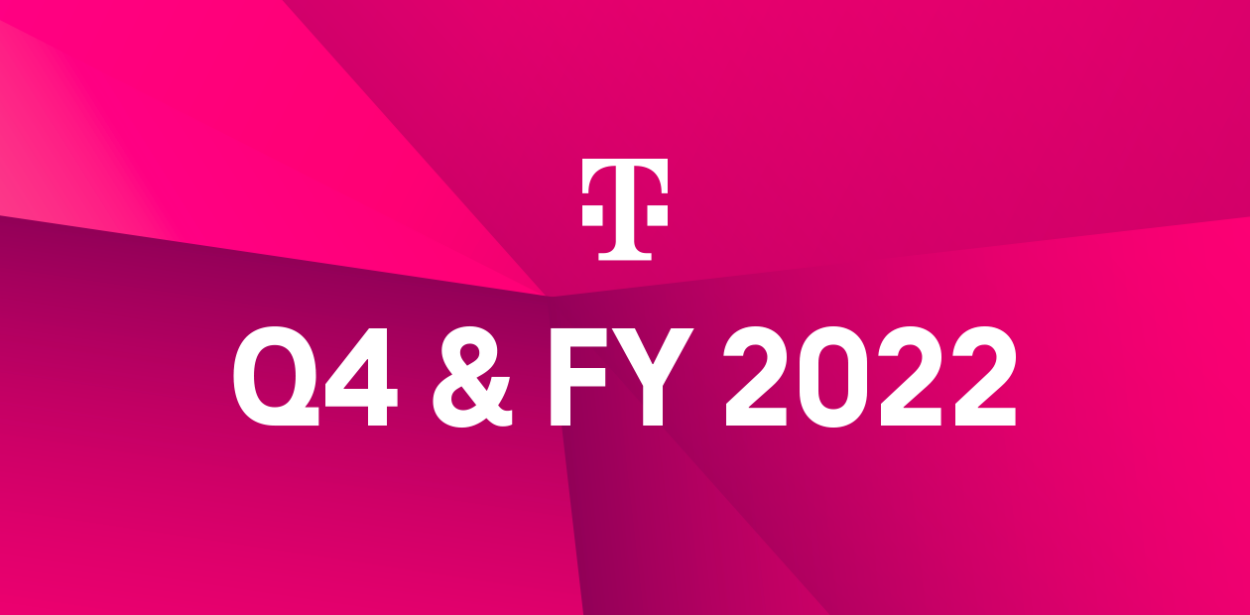
Industry-Leading and Record High Postpaid and Broadband Customer Growth in 2022
- Postpaid net account additions of 314 thousand in Q4 2022 — 1.4 million in 2022, record high(1)
Postpaid net customer additions of 1.8 million in Q4 2022 — 6.4 million in 2022, exceeded guidance
Postpaid phone net customer additions of 927 thousand in Q4 2022 — 3.1 million in 2022, only operator to grow year-over-year(1)
Postpaid phone churn of 0.92% in Q4 2022 — 0.88% in 2022, record low, only operator to improve
High Speed Internet net customer additions of 524 thousand in Q4 2022 — 2.0 million in 2022, industry-best
Differentiated Growth Model Unlocks Strong Financial Results and Accelerates Shareholder Returns in 2022
- Service revenues of $15.5 billion in Q4 2022 — $61.3 billion in 2022, record high
Postpaid service revenues of $11.7 billion in Q4 2022 — $45.9 billion in 2022, industry-leading growth of 8%
Net income of $1.5 billion in Q4 2022 — $2.6 billion in 2022, which included merger-related costs, decreased 14%
Core Adjusted EBITDA(2) of $6.6 billion in Q4 2022 — $26.4 billion in 2022, industry-leading growth of 12% and at high end of guidance
Net cash provided by operating activities of $4.3 billion in Q4 2022 — $16.8 billion in 2022, industry-leading growth of 21%, exceeded guidance
Free Cash Flow(2) of $2.2 billion in Q4 2022 — $7.7 billion in 2022, industry-leading growth of 36%, exceeded guidance
Repurchased 21.4 million shares of common stock in 2022 for $3.0 billion
Independent Third Party Experts Crown T-Mobile the New Overall Network Leader While Extending 5G Lead
- T-Mobile’s overall network performance swept the competition for the first time according to Ookla
Doing Good — The Un-carrier Way — Ranked Top 20 on America’s Most JUST Companies in 2023
- Committed to net-zero target by 2040, first in US wireless industry, and signed The Climate Pledge
Project 10Million connected more than 5.3 million students, more than halfway toward achieving its goal
Strong 2023 Outlook Driven by Continued Profitable Customer Growth and Merger Synergies
- Core Adjusted EBITDA(2) is expected to grow 10% at mid-point
Net cash provided by operating activities is expected to grow 8% at mid-point and Free Cash Flow(2) is expected to grow approximately 75% at mid-point
Bellevue, WA — February 1, 2023 — T-Mobile US, Inc. (NASDAQ: TMUS) reported fourth quarter and full-year 2022 results today, delivering industry-leading postpaid service revenue and cash flow growth in 2022, enabling the Un-carrier to begin shareholder returns earlier than planned. T-Mobile further extended its fame for value while translating its 5G lead into overall network leadership for the first time, resulting in the company’s lowest ever annual postpaid phone churn along with industry-best and record high postpaid account, postpaid customer and broadband customer growth in 2022.
"With record postpaid account and customer net adds that translated into industry-leading postpaid service revenue and cash flow growth, T-Mobile absolutely smashed 2022 by once again focusing on putting customers first,” said Mike Sievert, CEO of T-Mobile. “In true Un-carrier fashion, we have no plans to slow down in 2023. Now that we are being recognized as not only the 5G leader but the clear overall network leader in the U.S., our differentiated and sustainable growth strategy is opening up even bigger pathways for our future!"
Industry-Leading and Record High Postpaid Account, Postpaid Customer and Broadband Growth in 2022(1)
- Postpaid net account additions were 314 thousand in Q4 2022 and reached a record 1.4 million for 2022.
Postpaid net customer additions were 1.8 million in Q4 2022 and reached a record 6.4 million for 2022, above the high end of the company’s most recently increased annual guidance range of 6.2 to 6.4 million.
Postpaid phone net customer additions were 927 thousand in Q4 2022 and 3.1 million for 2022. Postpaid phone churn in Q4 2022 of 0.92% improved 18 basis points year-over-year, and 2022 churn of 0.88% improved 10 basis points year-over-year.
Prepaid net customer additions were 25 thousand in Q4 2022 and 338 thousand for 2022. Prepaid churn was 2.93% in Q4 2022, and 2022 churn of 2.77% was the lowest in company history.
High Speed Internet net customer additions were 524 thousand in Q4 2022 and 2.0 million for 2022. T-Mobile ended the year with 2.6 million High Speed Internet customers.
Total net customer additions were 1.8 million in Q4 2022 and reached a record 6.8 million for 2022. The total customer count increased to a record high of 113.6 million.
Strong Financial Results
- Total service revenues increased 4% year-over-year to $15.5 billion in Q4 2022 and 5% year-over-year to $61.3 billion in 2022, which included Postpaid service revenue growth of 7% year-over-year in Q4 2022 and 8% growth year-over-year in 2022.
Net income increased 250% year-over-year to $1.5 billion in Q4 2022 and decreased 14% year-over-year to $2.6 billion in 2022, which included, net of tax, merger-related costs of $3.7 billion and loss associated with the anticipated sale of the wireline business of $815 million. Diluted EPS increased year-over-year to $1.18 per share in Q4 2022 and decreased year-over-year to $2.06 per share in 2022.
Core Adjusted EBITDA increased 16% year-over-year to $6.6 billion in Q4 2022 and increased 12% year-over-year to $26.4 billion in 2022, primarily due to Service revenue growth and increased synergy realization.
Net cash provided by operating activities increased 45% year-over-year to $4.3 billion in Q4 2022 and increased 21% year-over-year to $16.8 billion in 2022, which included cash payments for merger-related costs of $622 million in Q4 2022 and $3.4 billion in 2022.
Cash purchases of property and equipment, including capitalized interest, increased 16% year-over-year to $3.4 billion in Q4 2022 and increased 13% year-over-year to $14.0 billion in 2022 driven by the accelerated build-out of the nationwide 5G network.
Free Cash Flow increased 96% year-over-year to $2.2 billion in Q4 2022 and increased 36% year-over-year to $7.7 billion in 2022, which included cash payments for merger-related costs of $622 million in Q4 2022 and $3.4 billion in 2022.
Common stock repurchases of 16.5 million shares for $2.3 billion in Q4 2022 and 21.4 million shares for $3.0 billion in 2022, with remaining authorization of up to $11.0 billion through the end of September 2023.
Independent Third Party Experts Crown T-Mobile the New Overall Network Leader While Extending 5G Lead
T-Mobile is the leader in 5G with the country’s largest, fastest, most reliable and most awarded 5G network. The company’s 5G network covers 325 million people (98% of Americans), and its super-fast Ultra Capacity 5G covers 265 million people nationwide. Approximately 60% of T-Mobile’s postpaid customers have a 5G phone and approximately two-thirds of all traffic is on 5G.
Furthermore, the Un-carrier’s 5G network leadership is translating into overall network leadership as noted by multiple third parties. For the first time, T-Mobile takes the crown as the overall network leader in America:
- Ookla: In its Q4 Speedtest Global Index Market Analysis of mobile providers, T-Mobile’s overall network performance swept the competition and placed first in all categories while its 5G network repeated major wins:Overall Network Performance: Fastest mobile operator in the US, lowest multi-server latency, most consistent network, best place to stream video
5G Network Performance: Best 5G network performance and most consistent 5G experience
Opensignal: T-Mobile secured major wins on overall network, winning seven of eight awards across experience (including video, games, voice and speeds) and consistency.
umlaut: In its latest 5G Network Performance Audit Report, T-Mobile was once again named as the most reliable 5G network in the country with the best coverage, stability and speeds.
Accelerated Integration Progress Positions T-Mobile to Approach Full Run-Rate Merger Synergies in 2023
T-Mobile achieved a huge milestone by substantially completing the network decommissioning in Q3 2022, less than 2.5 years post-merger closing, and more than a year ahead of the original merger plan. The company expects to substantially complete its integration by the end of 2023.
T-Mobile realized approximately $6.0 billion in Merger synergies in 2022, with $2.5 billion of selling, general and administrative (SG&A) expense reductions and $2.2 billion of cost of services expense reductions, which increased cash flows while funding growth initiatives and network build, and $1.3 billion in avoided network build costs.
The company incurred Merger-related costs of $592 million in Q4 2022 and $5.0 billion in 2022. Net of taxes, Merger-related costs were $444 million, or $0.36 per share, in Q4 2022 and $3.7 billion, or $2.97 per share, in 2022. Cash payments for merger-related costs were $622 million in Q4 2022 and $3.4 billion in 2022.
Doing Good — The Un-carrier Way — Industry Leader in Building a More Connected and Sustainable Future
T-Mobile continues to stay true to its commitment to use its network, scale and resources for good, building a more connected, equitable and sustainable future:
- The Un-carrier recently announced its most ambitious sustainability goal yet — to achieve net-zero emissions across the company’s entire carbon footprint by 2040, making T-Mobile the first U.S. wireless carrier to set a net-zero target that has been validated by the Science Based Targets initiative.
T-Mobile has also signed The Climate Pledge, joining other leading companies who vow to reach net-zero carbon emissions by 2040
Since launching Project 10Million in 2020, T-Mobile has focused on bringing critical connectivity to underserved students nationwide. Through the end of 2022, T-Mobile has provided $4.8 billion in services to connect more than 5.3 million students across the US.
T-Mobile received multiple recognitions in the fourth quarter:
JUST Capital ranked T-Mobile #20 on its 2023 Rankings of America’s Most JUST Companies, including #1 in the telecommunications industry for environment, in recognition of its ongoing progress and commitment to driving responsible business practices and positive environmental and social impact
Received 2022 Military Spouse Employment and Mentoring award from Hiring Our Heroes
Featured in Seramount’s 2022 Inclusion Index for progress on creating inclusive workplaces
Strong 2023 Outlook Driven by Continued Profitable Customer Growth and Merger Synergies
- Postpaid net customer additions are expected to be between 5.0 million and 5.5 million, expected to lead the industry for the 9th consecutive year.
Core Adjusted EBITDA, which is Adjusted EBITDA less lease revenues, is expected to be between $28.7 billion and $29.2 billion, up 10% year-over-year at the mid-point.
Merger synergies are expected to be between $7.2 billion and $7.5 billion, including $2.5 billion to $2.7 billion of SG&A expense reductions, $3.1 billion to $3.2 billion of cost of service expense reductions and approximately $1.6 billion in avoided network build costs.
Merger-related costs are expected to be approximately $1.0 billion before taxes. These costs are excluded from Core Adjusted EBITDA but will impact Net income, Net cash provided by operating activities and Free Cash Flow.
Net cash provided by operating activities, including payments for Merger-related costs, is expected to be between $17.8 billion and $18.3 billion, up 8% year-over-year at the mid-point.
Cash purchases of property and equipment, including capitalized interest, are expected to be between $9.4 billion and $9.7 billion.
Free Cash Flow, including payments for Merger-related costs, is expected to be between $13.1 billion and $13.6 billion, up approximately 75% year-over-year at the mid-point. Free Cash Flow guidance does not assume any material net cash inflows from securitization.
Financial Results
For more details on T-Mobile’s Q4 2022 and full-year 2022 financial results, including the Investor Factbook with detailed financial tables, please visit T-Mobile US, Inc.’s Investor Relations website at https://investor.t-mobile.com.
Earnings Call Information
Date/Time
- Wednesday, February 1, 2023, at 8:00 a.m. (ET)
Access via Phone (audio only)
Please plan on accessing the call 10 minutes prior to the scheduled start time.
- US/Canada: 877-390-2342
International: +1 309-216-6532
Access via Webcast
The earnings call will be broadcasted live and can be replayed via the Investor Relations website at https://investor.t-mobile.com.
Submit Questions via Twitter
Send a tweet to @TMobileIR or @MikeSievert using $TMUS
Contact Information
- Media Relations: This email address is being protected from spambots. You need JavaScript enabled to view it.
Investor Relations: This email address is being protected from spambots. You need JavaScript enabled to view it.
T-Mobile Social Media
Investors and others should note that we announce material financial and operational information to our investors using our investor relations website (https://investor.t-mobile.com), newsroom website (https://t-mobile.com/news), press releases, SEC filings and public conference calls and webcasts. We also intend to use certain social media accounts as a means of disclosing information about us and our services and for complying with our disclosure obligations under Regulation FD (the @TMobileIR Twitter account (https://twitter.com/TMobileIR), the @MikeSievert Twitter account (https://twitter.com/MikeSievert), which Mr. Sievert also uses as a means for personal communications and observations, and the @TMobileCFO Twitter Account (https://twitter.com/tmobilecfo), and our CFO’s LinkedIn account (https://www.linkedin.com/in/peter-osvaldik-3887394), both of which Mr. Osvaldik also uses as a means for personal communication and observations). The information we post through these social media channels may be deemed material. Accordingly, investors should monitor these social media channels in addition to following our press releases, SEC filings and public conference calls and webcasts. The social media channels that we intend to use as a means of disclosing the information described above may be updated from time to time as listed on our investor relations website.
About T-Mobile US, Inc.
T-Mobile US, Inc. (NASDAQ: TMUS) is America’s supercharged Un-carrier, delivering an advanced 4G LTE and transformative nationwide 5G network that will offer reliable connectivity for all. T-Mobile’s customers benefit from its unmatched combination of value and quality, unwavering obsession with offering them the best possible service experience and undisputable drive for disruption that creates competition and innovation in wireless and beyond. Based in Bellevue, Wash., T-Mobile provides services through its subsidiaries and operates its flagship brands, T-Mobile and Metro by T-Mobile. For more information please visit: https://www.t-mobile.com.
T‑Mobile Kicks Off 2023 as the Nationwide Network Leader
The Un‑carrier cements its place as THE network leader in the latest Ookla report, delivering the best experience for customers.
BELLEVUE, Wash. — Jan. 17, 2023 — New year, new bragging rights for T-Mobile customers. T-Mobile (NASDAQ: TMUS) today announced its network once again earned top honors in Ookla's Speedtest® Global Index Market Analysis United States Q4 2022 report. With top marks in every single category for overall network performance and repeated wins for 5G, T-Mobile is hitting the ground running in 2023 as the national network leader for customer experience. In addition to topping national rankings, T-Mobile’s network proved fastest in 45 states and the District of Columbia as well as in 86 of the 100 most populous U.S. cities.
"We’ve long led the industry in 5G, but we've had our sights on more than 5G leadership," said Neville Ray, President of Technology at T-Mobile. “We're taking the crown as the overall network leader in America by expanding our coverage and game-changing speeds to deliver the best experience and value to customers across the nation, and we've only just begun to show what T-Mobile's network can do."
T-Mobile's overall network performance swept the competition and placed first in all categories:
- Fastest mobile operator in the U.S. with median download speeds more than 2x faster than Verizon and AT&T at 151.37 Mbps and median upload speeds recorded at 12.52 Mbps.
- Lowest multi-server latency, meaning faster response times for gamers, improved IoT solutions for businesses and more.
- Most consistent network, meaning customers have faster speeds more consistently than Verizon and AT&T users.
- Best place to stream video with the highest video score ranking.
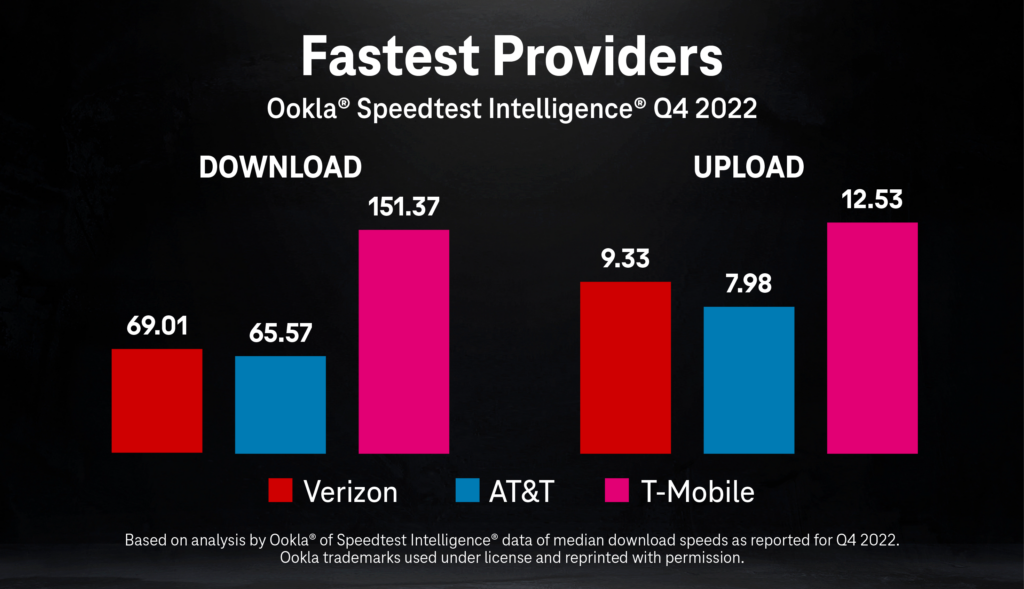
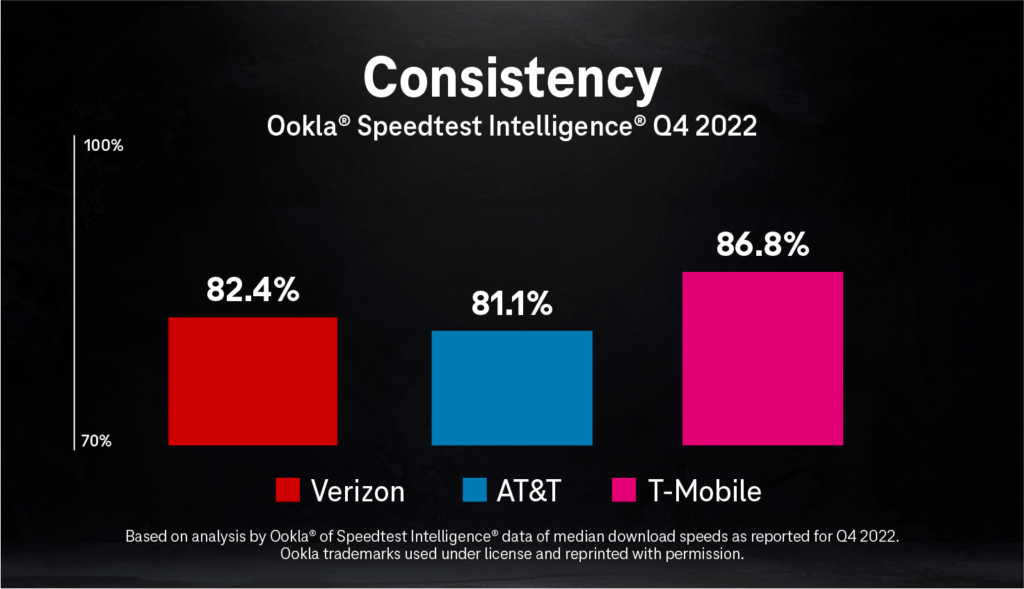
When measuring 5G performance, T-Mobile also repeated some major wins in Q4:
- 5G Performance: Clocked average download speeds at a blazing 216.56 Mbps — over 2.5x faster than AT&T
- 5G Consistency: T-Mobile customers enjoy a more consistent 5G experience compared to Verizon and AT&T
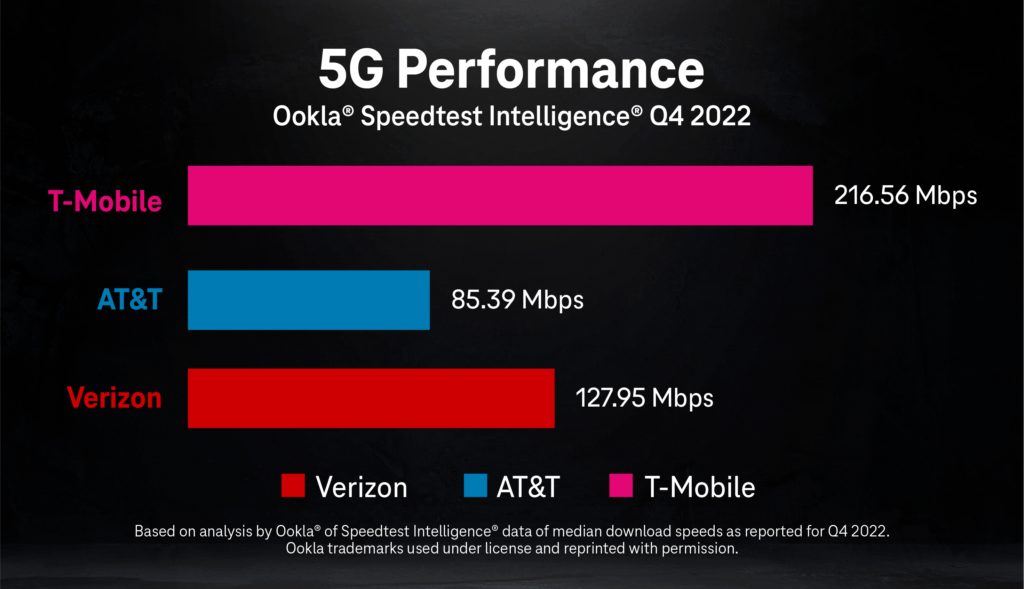
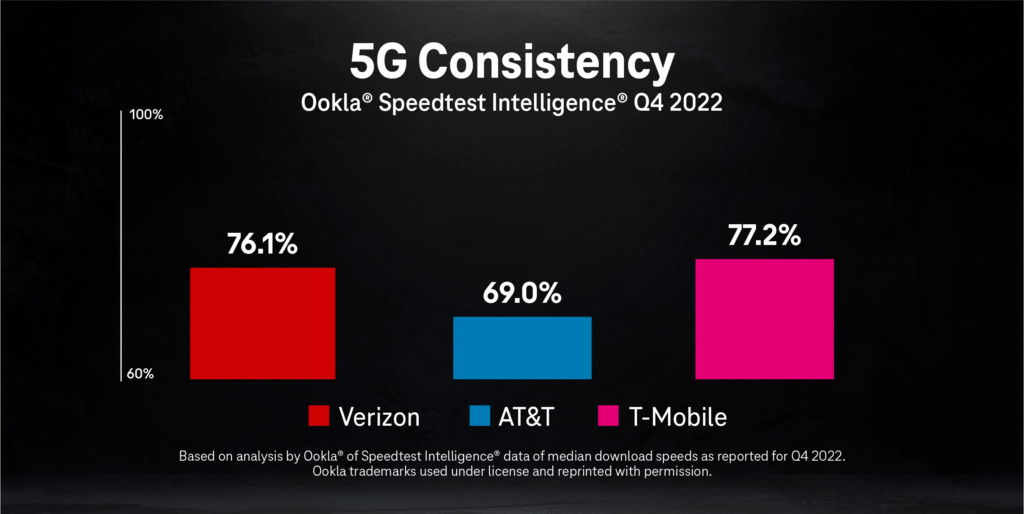
Third-party researchers, industry analysts and reporters put network capabilities through the crucible with continuous testing across the U.S. and T-Mobile’s 5G network has consistently outranked competitors since 2020.
T-Mobile is America’s 5G leader, delivering the country’s largest, fastest, most reliable and most awarded 5G network. The Un-carrier’s Extended Range 5G covers 323 million people across 1.9 million square miles – more area than AT&T and Verizon combined. 260 million people nationwide are covered by T-Mobile’s super-fast Ultra Capacity 5G, and the Un-carrier plans to reach 300 million people with Ultra Capacity by the end of this year.
For more information on T-Mobile’s network, visit T-Mobile.com/coverage.
Follow T-Mobile’s Official Twitter Newsroom @TMobileNews to stay up to date with the latest company news.
###
See 5G device, coverage, & access details at T-Mobile.com.
Based on analysis by Ookla® of Speedtest Intelligence® data for the U.S., Q4 2022. Ookla trademarks used under license and reprinted with permission.
T‑Mobile and Delta Air Lines Join Forces to Deliver Free In‑flight Wi‑Fi

What’s the news: Delta SkyMiles® Members get free Wi-Fi all flight long on Delta beginning Feb.
- The expanded partnership with Delta delivers more flights with free Wi-Fi for T-Mobile customers and personalized in-flight experiences to come this spring.
2. Why it matters: It’s 2023 — staying connected while traveling should be easy.
3. T-Mobile customers already get free in-flight Wi-Fi, and now T-Mobile and Delta are bringing it to all travelers flying Delta.
Who it’s for: The millions of people looking to stay connected while traveling. Today, T-Mobile (NASDAQ: TMUS) and Delta Air Lines announced SkyMiles Members flying Delta, regardless of their wireless provider, can get fast, free Wi-Fi all flight long. Both T-Mobile and Delta share the importance of staying connected wherever life leads — even at 30,000 feet. This partnership fuels the vision for a more connected travel experience for all.
“At T-Mobile, we believe staying connected while traveling should be an easy, seamless experience,” said Mike Sievert, T-Mobile CEO. “T-Mobile customers already get free in-flight Wi-Fi, and now we’re partnering with Delta to bring that experience to all SkyMiles Members so that anyone flying Delta can enjoy online access from takeoff to touchdown.”
Travel is expected to soar in 2023, with over two-thirds of people feeling more optimistic about traveling this year compared to last. And staying connected is such a major priority that more than half of global travelers say having a phone and connectivity is non-negotiable. And that’s where T-Mobile and Delta come in. Kick back, scroll, stream and say goodbye to in-flight FOMO.
Free Wi-Fi will be rolling out to most domestic mainline Delta flights starting February 1, with more than 700 aircraft expected to offer free Wi-Fi by the end of 2023. Expansion to international and regional routes is expected by the end of 2024. The service includes free Wi-Fi all flight long — available on smartphones, tablets and laptops. To connect, passengers simply need to log in to their Delta SkyMiles account – or sign up for free – while on the ground or on the plane.
What’s more, Delta’s in-flight Wi-Fi connection portal will be refreshed later this spring with the airline’s new Delta Sync Exclusives hub, which will bring the vision of more personalized travel to life. T-Mobile’s partnership with Delta will enable this new SkyMiles-unlocked mobile platform launching later this year that will feature personalized content, entertainment, exclusive offers and more, from brands customers know and love.
“The ability to stay connected while seeing the world is simply foundational. Delta’s new partnership with T-Mobile signifies another exciting step forward as we lead the industry in delivering a differentiated onboard experience that’s as comfortable and personalized as sitting in your own living room,” said Delta CEO Ed Bastian.
Last year, T-Mobile launched Coverage Beyond — the Un-carrier move that gave customers on T-Mobile’s most popular plans the ability to search and stream all flight long where available, on four of the biggest U.S. airlines. This expanded partnership with Delta brings more flights with free Wi-Fi for T-Mobile customers and starting February 1, that experience expands to all Delta SkyMiles Members – yep, even AT&T and Verizon customers.
T-Mobile’s industry-leading travel benefits are just part of the unbeatable value that comes with being a T-Mobile customer — it’s almost like finding extra money in the bank every month. Customers can get $225 worth of extra stuff with their Magenta MAX plan with 2+ lines. For real. Only Un-carrier customers get free high-speed data abroad in 215+ countries and destinations, AAA for a year on Us, Apple TV+ on Us, Netflix on Us, free Scam Shield Premium and so much more — all on top of their wireless service on the nation’s largest, fastest and most reliable 5G network.
To learn more about T-Mobile’s travel benefits, visit t-mobile.com/travel. For more information on T-Mobile for Business travel benefits, head to http://t-mobile.com/business/plans/travel-benefits.
Follow T-Mobile’s Official Twitter Newsroom @TMobileNews to stay up to date with the latest company news.
In-Flight Connection: Unlimited where available on select U.S. airlines with MAX plans; 4 full-flight sessions per year with Magenta plans. $225 in benefits based on the retail value of monthly benefits available with MAX family plans, like entertainment, travel benefits, and scam call protection. Some benefits may require activation.
About T-Mobile T-Mobile US, Inc.
(NASDAQ: TMUS) is America’s supercharged Un-carrier, delivering an advanced 4G LTE and transformative nationwide 5G network that will offer reliable connectivity for all. T-Mobile’s customers benefit from its unmatched combination of value and quality, unwavering obsession with offering them the best possible service experience and undisputable drive for disruption that creates competition and innovation in wireless and beyond. Based in Bellevue, Wash., T-Mobile provides services through its subsidiaries and operates its flagship brands, T-Mobile, Metro by T-Mobile and Sprint. For more information please visit: https://www.t-mobile.com.



